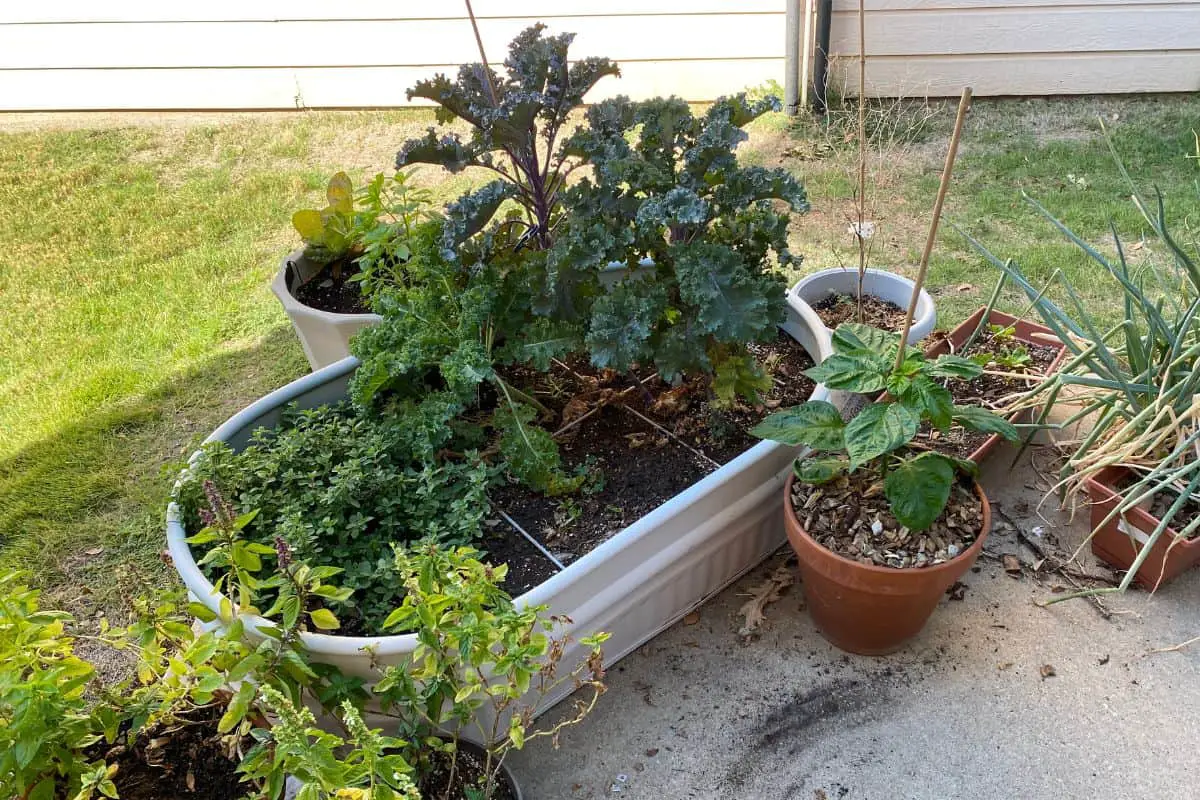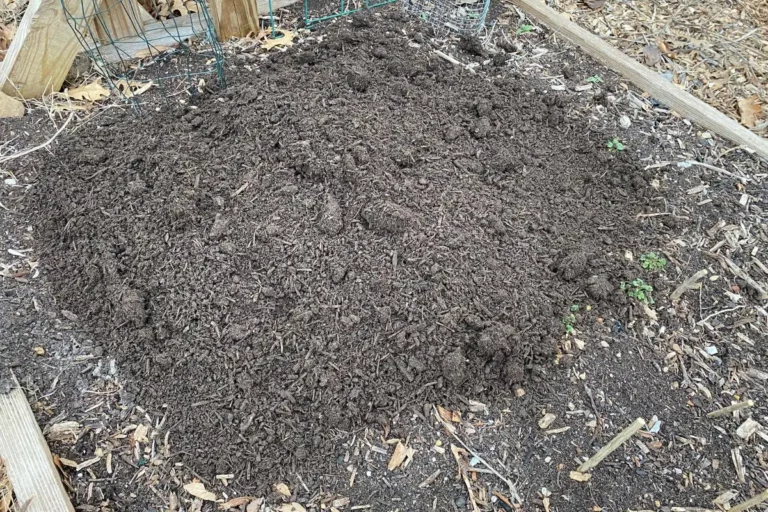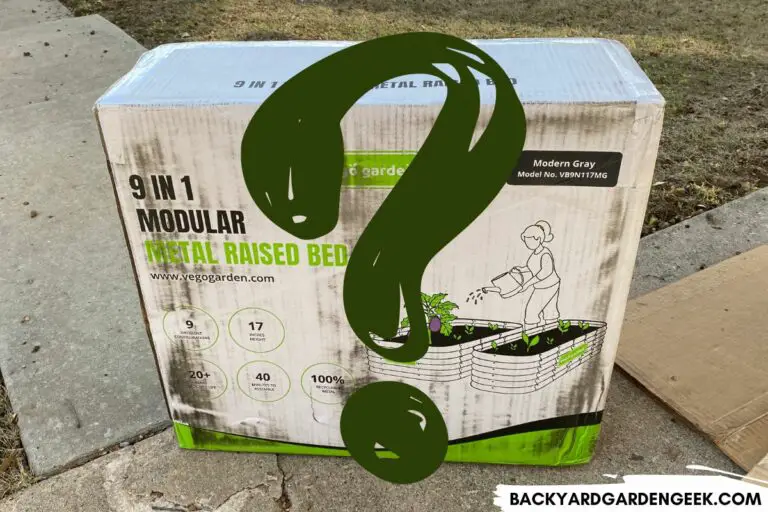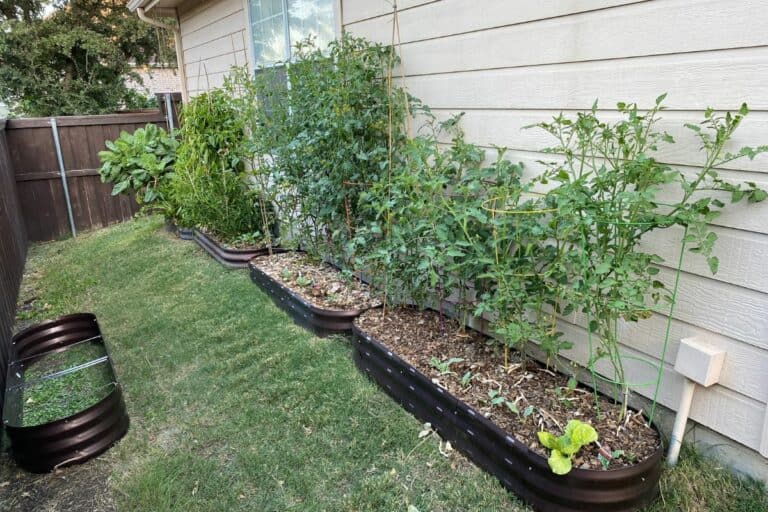Putting Raised Beds on the Patio: Should You Do It?
I spend a lot of time on my patio: reading books, working the grill, and eating outside with my family. But I wanted to expand my garden last year, and I began thinking that the patio offered a great space for me to garden.
So I got to thinking: Are patios good for raised garden beds? Would my plants grow well there, and would they get enough sunlight? What were the downsides of putting a raised bed on the patio?
With these thoughts in mind, I bought a raised bed, and I’ve been gardening on my patio for the past 2 years. Here’s what I’ve learned along the way.
Patios are a great place for raised garden beds, offering an ideal spot for flowers, herbs, micro dwarf tomatoes, and shallow-rooted vegetables such as arugula, beets, bok choy, chives, garlic, kale, kohlrabi, lettuce, mint, onions, radishes, shallots, spinach, strawberries, and swiss chard.
Assuming there’s plenty of sunlight for plants to grow and enough structural strength to safely support the weight of a soil-filled raised bed, the patio is an ideal location for gardeners interested in maximizing their gardening space.
In this article, I’ll covered several important things:
- advantages of putting raised beds on your patio
- things to keep in mind when it comes to sunlight, watering, and common mistakes
- a list of ideal plants for raised bed patio gardening plus info about each
- tips to keep plants alive during hot summer and cold winter months
If you’re interested in creating a patio garden that thrives, read below to learn what I’ve learned over the past few years while avoiding some of the mistakes I made early on.
You might also want to get your hands on a good Tractor Supply Company water trough.
You can see photos of my water trough below, but I can tell you this: It makes for an amazing raised patio bed since, unlike many raised beds, water troughs have metal bottoms that keep the soil contained.
(Water troughs are a little pricey, but they’ll last for 20+ years, so I think they’re worth the investment.)
I removed the stickers, drilled holes in the bottom, and spray-painted the outside of mine to make it look nice, then filled it with lots of compostable materials and high-quality garden soil. The results have been fantastic!
Now that I’ve covered the basics, let’s look at some things to consider when putting raised garden beds on your patio.
Advantages to Raised Bed Patio Gardening
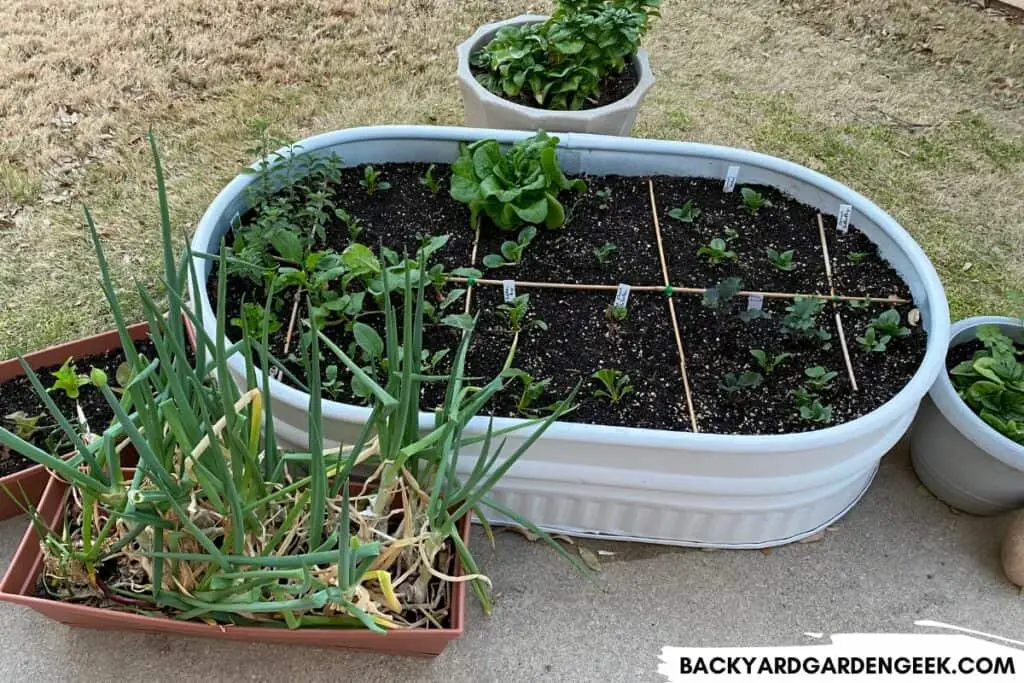
If you’ve been gardening in your backyard for any amount of time, you’re likely well aware that pots, planters, and even grow bags are great ways to garden on your patio.
But have you ever tried installing raised beds on your patio?
If you’ve considered doing so, here are 5 advantages to having raised beds on your patio:
1. Raised Beds Make Gardening Convenient
Whether you’d like to garden as close to home as possible or you’ve been struggling with mobility issues, raised beds offer the opportunity to grow all kinds of plants with easy year round access for doing so.
As long as you give some initial thought to the proper materials and placement of your raised beds, you’ll be able to access your raised patio bed easily and garden on your patio for many years.
2. Raised Beds and Increased Growing Space
My patio is relatively small, which means that containers take up lots of space while keeping my growing capacity to a minimum.
The same can’t be said for a quality raised bed. If you put a raised bed on your patio, you’ll suddenly have lots more room for plants to grow, and you’ll also be able to grow a much wider variety of plants than you could have otherwise done with pots and planters alone.
For me, this was the best selling point for putting a raised bed on my patio. I was able to increase the amount of herbs and vegetables I grew on my patio by over 100% once I took the space previously reserved for pots and put a raised bed there instead.
3. Soil Health and Raised Beds
Unlike the native soil in your backyard, the soil in your raised bed is yours to select and cultivate.
What this means is that you can thoughtfully consider the kinds of soil you want to add to your raised bed, and you can easily amend that soil year after year to keep it as you’d like it to be.
In fact, you can save lots of money and create wonderful, cheap soil by filling raised beds with compostable materials (branches, kitchen scraps, leaves, etc.) instead of doing so entirely with soil.
Over time, you’ll not only save money. You’ll also fill your raised beds with a nutrient-rich soil that’ll allow plants to thrive each year.
4. Water Drainage in Raised Patio Beds
If you’ve had drainage issues with the native soil in your backyard, then a raised bed on your patio might be an easy way to avoid water problems while growing your favorite plants each year.
As long as your patio is properly pitched, the water in your raised bed will drain out and run away from your house.
But if you’ve noticed pools of water on your patio, you’ll want to get in touch with a local handyman or expert contractor to test the pitch to determine whether you’ve got any possible issues before putting a raised bed on your patio.
5. Raised Beds and Aesthetic Appeal
Have you looked around online or in your local garden center for raised beds recently? If so you’ve likely noticed that there are all kinds of styles, configurations, and colors, enough variety to satisfy literally any preference.
What this means is that adding raised beds to your patio can increase its aesthetic appeal along with your growing space.
I bought a galvanized metal water trough from Tractor Supply Company, but to make it more aesthetically pleasing, I peeled off the TSC label, then spray painted the entire thing.

I now have a beautiful raised bed on my patio that gets immediate attention every time someone visits my house.
Things to Consider When Putting Raised Beds on a Patio
Now that we’ve covered the advantages of putting raised beds on your patio, I’d like to share some information with you that I learned through trial and error.
When it comes to raised patio beds, I strongly recommend purchasing a metal bed instead building or buying a wooden one, especially metal water troughs like the kind you can find at Tractor Supply Company.
Wooden beds will rot over time, even when built using the hardiest kind of wood. And many metal beds are open in the bottom, which means you’ll want to consider lining the bottom of your bed to put a barrier between the dirt and the concrete or stone.
With metal water troughs, you won’t have this problem. You’ll have to drill plenty of drainage holes in the bottom of the trough–so you’ll need a good drill and sharp metal bits to do so–but once you’ve drilled those holes, you’ll have a perfect bed for patio gardening, one that will last for many, many years.

With patio raised beds, you’ve also got to pay close attention to sunlight before placing the bed and filling it up with soil.
The last thing you want to do is to fill up the entire bed with soil only to realize that you need to move it somewhere else on your patio. That’ll involve lots of time spent emptying and refilling the bed.
Instead, pay close attention to where and how often sunlight reaches your patio area. Be sure to note how much sunlight you get in both summer and winter months because parts of your patio that are in sunlight during the summer might be in shade during the fall and winter due to the rotation of the Earth.
You don’t need tons of sunlight. As long as your bed gets a few hours of sunlight each day, you can grow lots of plants.
Mine only gets about 4 total hours of sunlight, but I was able to grow beets, bok choy, various herbs, kale, lettuce, and radishes in mine this past year.

When it comes to water, you need to make sure your patio is pitched properly, as I noted above.
My pitch is just fine, so if there’s ever any water runoff, it runs out of the bottom of my raised bed and into my yard.
This is especially important for concrete and stone patios since you don’t want water to run out of your raised bed and then pool on your patio, which can cause a slipping hazard and potential long-term damage to the patio surface.
If you’re gardening on a wooden patio deck, you’ll need to think carefully about whether it’s worth it to put a raised bed there. I probably wouldn’t for fear that the weight plus the water might damage the deck or, over time, cause it to rot a bit quicker than it would have otherwise.
When I lived in New Jersey, I had a wooden patio deck that I filled with containers. I now prefer raised beds, but that’s only because, here in Texas, I have a concrete patio to garden on.
Here’s one other common mistake to consider: Don’t plant vegetables in your raised patio beds that have deep root systems or require lots of staking.
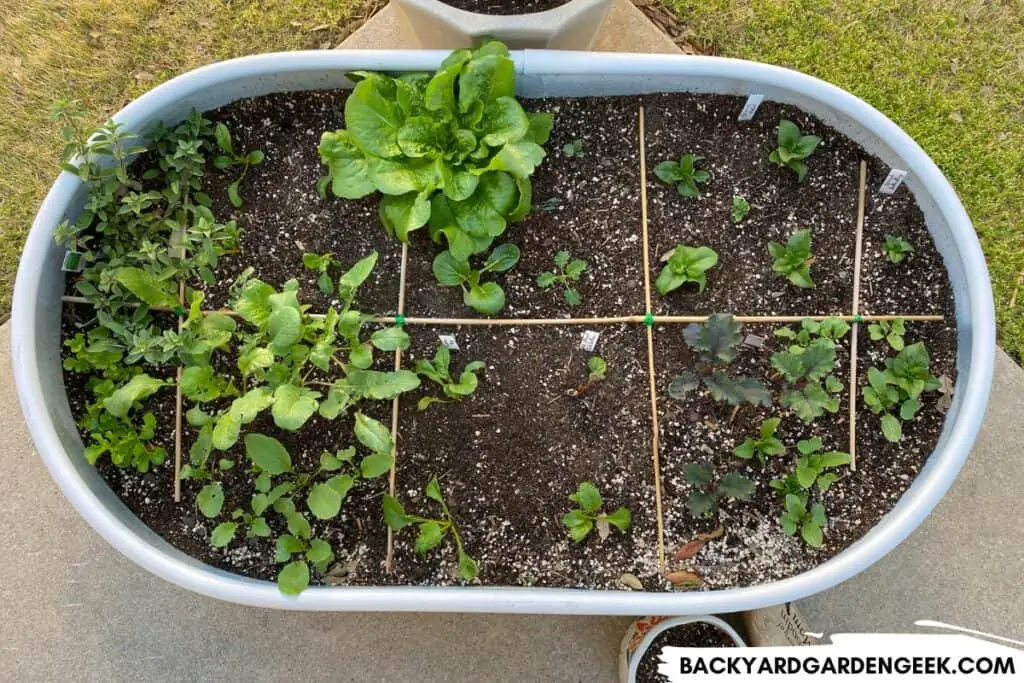
I tried growing a dwarf tomato plant in my raised bed last year, and although it grew fine for a while, it was a pain to support the plant and keep it healthy. With the exception of micro dwarf or container varieties, I’ll put my tomato plants in the raised beds that I’ve got elsewhere in my backyard.
I imagine that kind of headache would only increase if you grow vining plants in a raised patio bed. I’ve never done this, and I don’t recommend doing so.
There’s usually not enough support nearby for cucumbers, melons, and other vining veggies, although vining flowers would probably be just fine assuming you’ve got some kind of trellis structure and you’re willing to prune them back when necessary.
With that being said, I’d like to take a quick look at the vegetable varieties that I recommend growing in raised patio beds, assuming you’ve built or purchased a bed that’s at least 12-17 inches deep (30-43 cm):
| Plant | Recommended | Not Recommended |
|---|---|---|
| Arugula | ✔ | |
| Basil | ✔ | |
| Bean | ✔ | |
| Bok Choy | ✔ | |
| Broccoli | ✔ | |
| Brussels Sprouts | ✔ | |
| Cabbage | ✔ | |
| Carrot | ✔ | |
| Cauliflower | ✔ | |
| Celery | ✔ | |
| Chives | ✔ | |
| Cilantro | ✔ | |
| Collards | ✔ | |
| Corn | ✔ | |
| Cucumber | ✔ | |
| Eggplant | ✔ | |
| Dill | ✔ | |
| Fennel | ✔ | |
| Garlic | ✔ | |
| Kale | ✔ | |
| Kohlrabi | ✔ | |
| Lavender | ✔ | |
| Leek | ✔ | |
| Lemongrass | ✔ | |
| Lettuce | ✔ | |
| Marigold | ✔ | |
| Marjoram | ✔ | |
| Melon | ✔ | |
| Mint | ✔ | |
| Mustard | ✔ | |
| Okra | ✔ | |
| Onions | ✔ | |
| Oregano | ✔ | |
| Parsley | ✔ | |
| Parsnip | ✔ | |
| Pea | ✔ | |
| Pepper | ✔ | |
| Potato | ✔ | |
| Pumpkin | ✔ | |
| Radish | ✔ | |
| Rutabaga | ✔ | |
| Rosemary | ✔ | |
| Rue | ✔ | |
| Sage | ✔ | |
| Shallot | ✔ | |
| Spinach | ✔ | |
| Squash | ✔ | |
| Strawberry | ✔ | |
| Sweet Potato | ✔ | |
| Swiss Chard | ✔ | |
| Sunflower | ✔ | |
| Tansy | ✔ | |
| Tarragon | ✔ | |
| Tomatillo | ✔ | |
| Tomato | ✔ | |
| Thyme | ✔ | |
| Turnip | ✔ | |
| Watercress | ✔ | |
| Watermelon | ✔ | |
| Zinnia | ✔ |
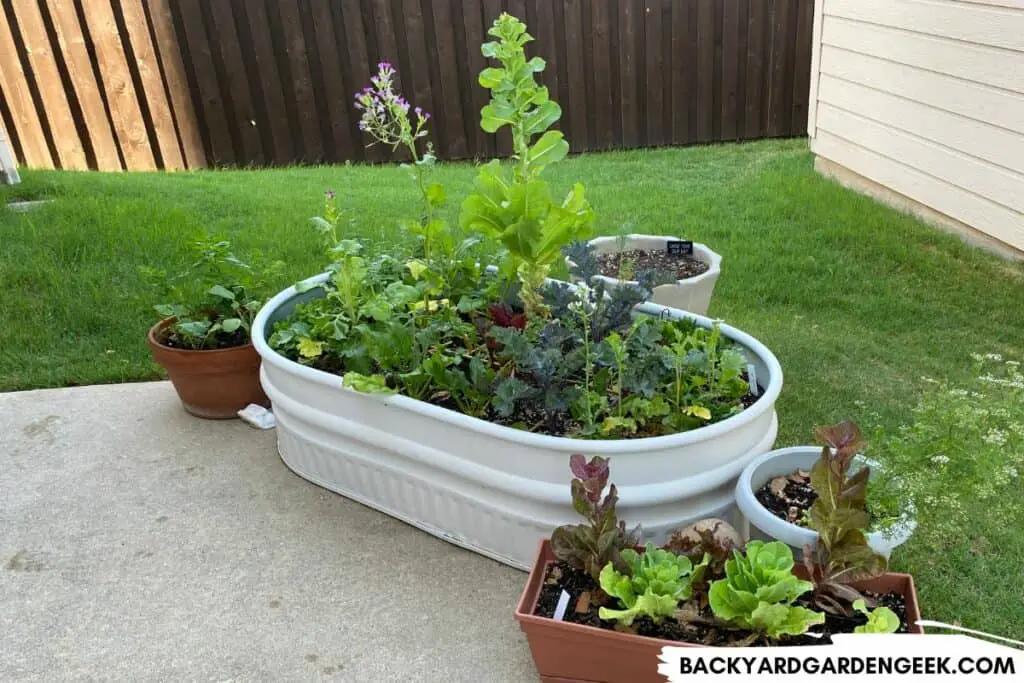
Patio Gardening in Raised Beds During Summer and Winter
If you’ve putting a raised bed on your patio this year, you’ll want to know keep in mind a few things I’ve learned when gardening on my patio during the hottest and coldest months of the year.
Here are my recommendations for the hottest summer months:
- Leave room at the top of your raised patio bed for 2-3 inches of mulch. Your plants will likely need daily watering if you live in an area where the temperatures get very hot during the summer, and that mulch will help keep your soil as moist as possible.
- Water your plants in the mornings during the summer. If you wait until later in the day, your soil will most likely dry out more than it would have otherwise, and you’ll potentially encourage root rot if you water consistently right before the sun sets.
- Plants get stressed out when hot weather arrives, so keep a close eye on your plants. If you notice any of the telltale signs of aphids, armyworms, cabbage loopers, cucumber beetles, harlequin bugs, slugs or snails, spider mites, stink bugs, whiteflies, or any other garden pests, take action quickly.
Here are some articles I’ve written about pest management strategies in case you’d like to learn more about how to stop the bad bugs before they destroy your garden plants:
- 21 Plants That Aphids Love to Attack + How to Stop Them
- 27 Plants that Resist, Repel, and Trap Spider Mites
- Can Plants Recover from Spider Mites? What You Need to Know
- Why Do Ants Protect Aphids? 7 Things You Should Know
- Will Aphids Spread to Other Plants?
- Will Neem Oil Kill or Repel Ants? All You Need to Know
When it comes to gardening in raised beds on your patio during the winter months, here’s some advice I wished I’d known last year:
- Do you live in an area where the winters are super frigid? If so, you might consider planting a cover crop in your raised beds once fall arrives. You’ll need to do some research to find out what works best in your region, but there are all kinds of possibilities out there.
- If it’s simply too cold for that sort of thing or if you have no interest in doing so, remove all of the dead or dying plants in fall, then mulch the raised bed heavily. That mulch will keep the soil nicely covered until spring.
- For those who live in areas that experience more temperate winters, you might be able to garden all winter long in your raised patio bed. Last season, I had kale plants and an oregano plant that had been alive for over a year in my raised bed.
- The key to keeping these plants alive will be to cover the entire bed well whenever cold weather or freezing temperatures arrive.
- I’ve had lots of success with frost covers. Simply purchase a product that you can wrap around your raised bed to keep your plants snug when the cold weather arrives. I use a few bricks to hold my frost covers down, and they’ve worked great!
- If winter weather is on the horizon, water the plants in your raised bed 24 hours in advance of the storm. That way, they’ll have plenty of time to pull that water into their systems, which will give them a little added buffer against freezing temperatures.
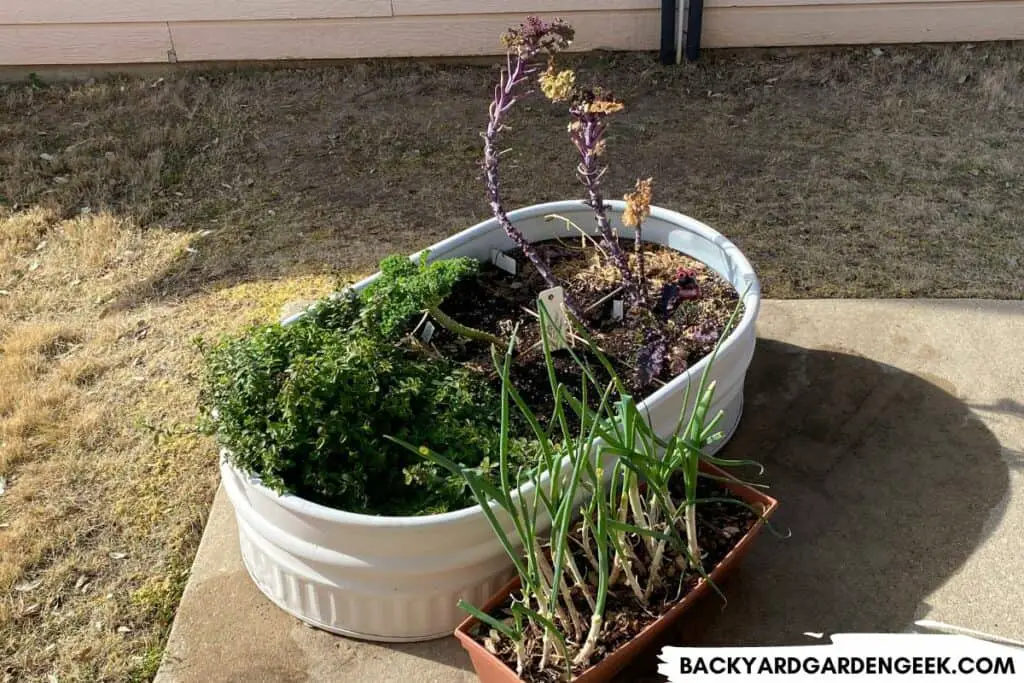
As you can see from this article, there’s lots of possibilities when it comes to raised patio beds and also lots of opportunities to grow incredible plants on your patio.
You’ll need to consider a variety of factors so that you don’t make any common mistakes, but as long as you do so, you’ll be able to grow all kinds of plants just a few steps away from your house.
Additional Reading
If you’ve enjoyed this article on putting raised garden beds on patios, you might be interested in reading more about gardening using raised beds:
